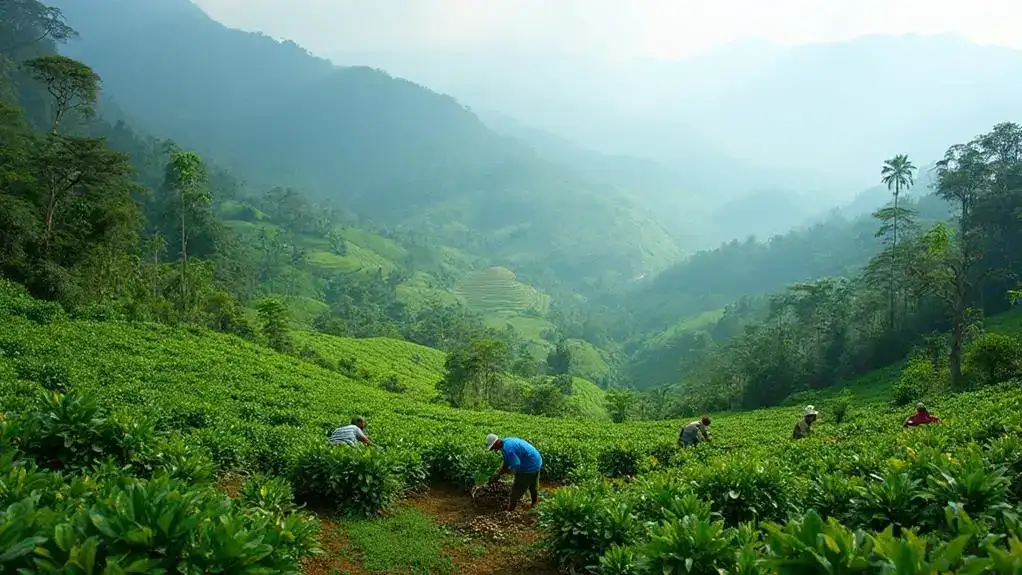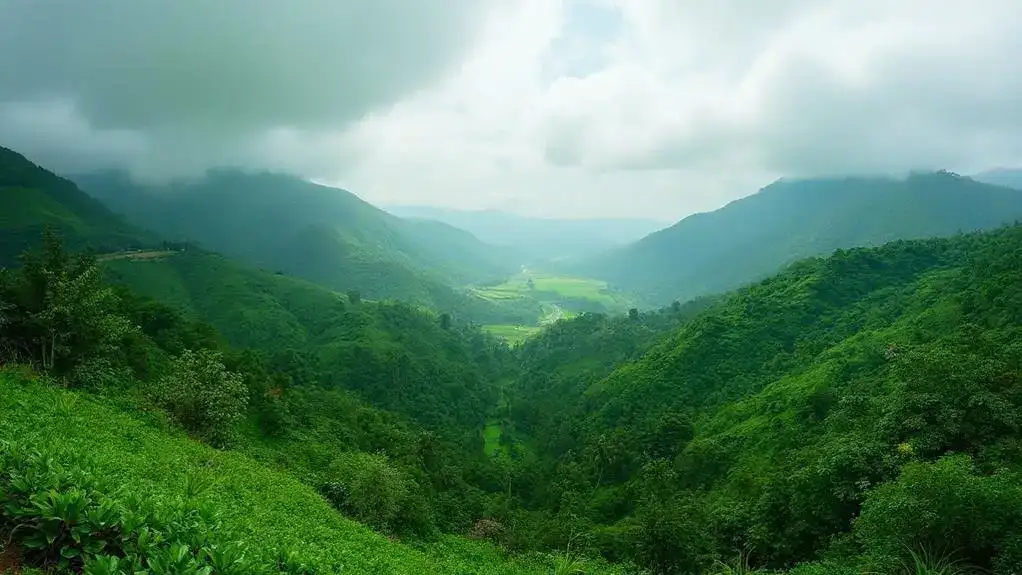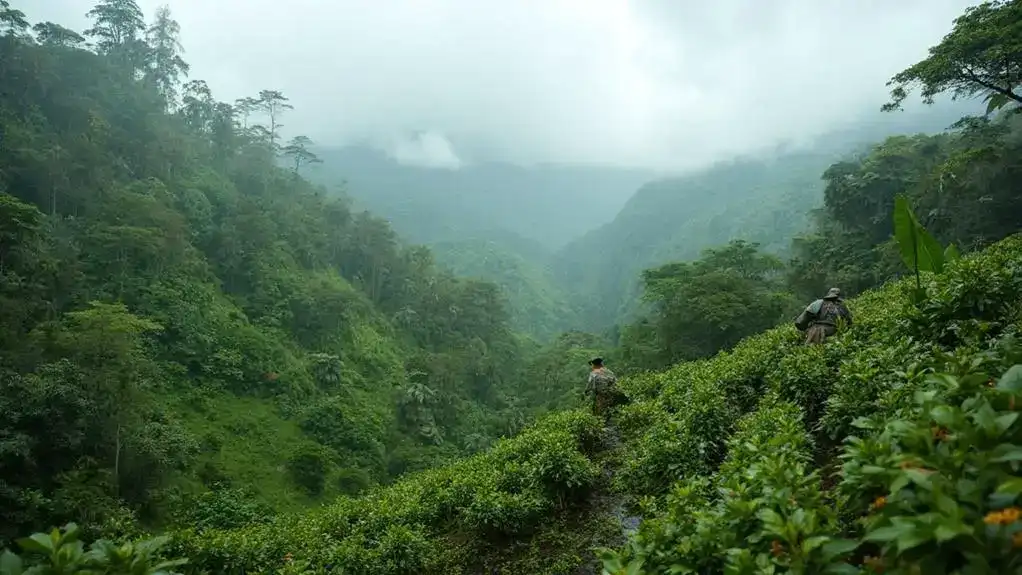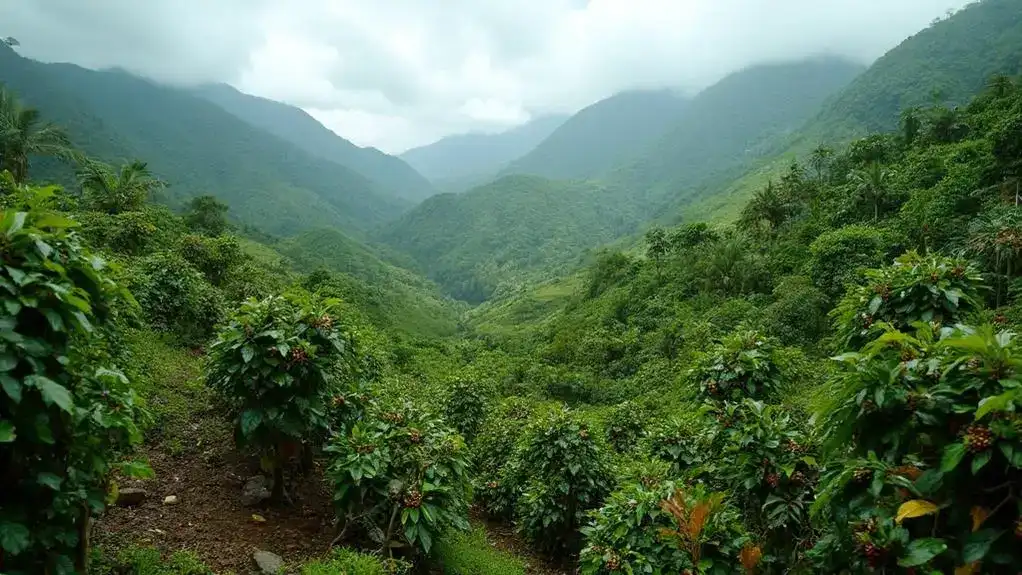Sumatra’s coffee-growing regions each offer unique flavor profiles, reflecting their diverse climates and geographies. For instance, the Gayo Highlands produce bright, fruity Arabica, while the Mandheling region is known for its rich, earthy tones. The Lintong area features complex notes of chocolate and spice. Various processing methods, like wet-hulling and traditional drying, further enhance these distinctive qualities. Altitude, soil type, and rainfall patterns greatly affect coffee flavor and quality. This diversity makes Sumatran coffee globally favored, appealing to various palates. Explore further to discover the unique characteristics of these growing regions and how each contributes to the world of coffee.
Sumatra Coffee Growing Regions
 coffee cultivation areas”/>
coffee cultivation areas”/>When exploring the coffee-growing regions of Sumatra, you’ll discover several key areas that each produce unique flavors and qualities.
From the rich, full-bodied Mandheling coffee to the bright and fruity profiles of the Gayo Highlands, each region offers something distinct.
Understanding these areas can enhance your appreciation for Sumatran coffee and the diverse tastes it brings to your cup.
Key Coffee Producing Areas
In the lush landscapes of Sumatra, key coffee producing areas showcase the island’s rich agricultural heritage and diverse flavor profiles.
These regions contribute considerably to Indonesia’s vibrant coffee culture, each offering unique characteristics that appeal to coffee lovers worldwide.
Here are four notable areas:
- Gayo Highlands: Known for bright, fruity Arabica coffee, thanks to high altitudes and cool climates.
- Mandheling Region: Celebrated for its rich, full-bodied coffee with earthy undertones, often processed using traditional methods.
- Lintong Region: Produces coffee with complex flavor profiles, featuring chocolate and spice notes.
- Bireuen: Renowned for its sweet and fruity Arabica beans, cultivated using sustainable practices.
This regional diversity enhances the overall quality and flavor of Sumatran coffee, making it a global favorite.
What Are the Coffee Varieties and Characteristics in Sumatra?
When exploring Sumatra’s coffee varieties, you’ll find a rich tapestry of flavors and characteristics.
The region is primarily known for its Arabica beans, which thrive in the high-altitude areas, while Robusta varieties also play a role in the coffee landscape.
Each area contributes unique flavor profiles, ranging from earthy and spicy to bright and fruity, making Sumatran coffee a favorite among enthusiasts.
Types of Coffee Grown in Sumatra
Although Sumatra is renowned for its unique coffee-growing regions, the types of coffee produced there showcase a remarkable variety of flavors and characteristics.
The coffee cultivation methods used in Sumatra contribute considerably to this flavor diversity. Here are some notable types of coffee grown in the region:
- Arabica: Known for its bright acidity and fruity flavors, often cultivated in high-altitude areas like the Gayo Highlands.
- Robusta: Typically found in lower elevations, offering a stronger, more bitter taste, favored for blends.
- Mandheling: Famous for its full-bodied profile and earthy notes, usually processed with the wet-hulling method.
- Lintong: Characterized by complex flavors, including chocolate and spice, often enjoyed by specialty coffee drinkers.
Together, these varieties reflect the rich tapestry of Sumatra’s coffee landscape.
What Are the Flavor Profiles of Sumatran Coffee?
The flavor profiles of Sumatran coffee are as diverse as the regions they come from, showcasing unique characteristics that appeal to a wide range of coffee lovers. Each region offers distinct flavor nuances, influenced by altitude, soil, and processing methods. For instance, Aceh’s coffee often has earthy and spicy notes, while Gayo Highlands produce bright, fruity flavors. Here’s a quick look at some key regional variations:
| Region | Flavor Profile |
|---|---|
| Aceh | Earthy, spicy |
| Gayo Highlands | Bright, fruity |
| Mandheling | Rich, full-bodied |
| Lintong | Chocolate, spice |
Exploring these regional variations can enhance your appreciation for Sumatran coffee’s rich tapestry of flavors.
How Does Climate and Geography Affect Coffee Quality in Sumatra?

In Sumatra, the climate and geography play essential roles in shaping the quality of coffee.
You’ll find that high altitudes and rich volcanic soil contribute to the unique flavors and aromas of the beans, while consistent rainfall and humidity create ideal growing conditions.
Understanding these factors can help you appreciate the distinct characteristics of Sumatran coffee even more.
Climate Conditions in Sumatra’s Coffee Regions
Situated within the equatorial zone, Sumatra’s coffee regions benefit from a climate that fosters the growth of high-quality coffee beans. The interplay of altitude effects and climate variability greatly influences the flavor profiles of the beans. higher elevations, cooler temperatures, and abundant rainfall create ideal conditions for Arabica coffee, known for its vibrant acidity and complex flavors.
| Climate Factor | Impact on Coffee Quality |
|---|---|
| Altitude | Enhances acidity and complexity |
| Rainfall | Promotes healthy plant growth |
| Temperature | Affects flavor development |
| Soil Type | Influences taste and aroma |
| Processing Method | Impacts final flavor profile |
These factors collectively shape the unique characteristics of Sumatra’s diverse coffee offerings, making it a sought-after destination for coffee enthusiasts.
Geographic Influence on Coffee Quality
Geography plays a significant role in shaping the quality of coffee grown in Sumatra. The island’s geographic diversity results in unique coffee terroirs, where factors like altitude, climate, and soil composition influence flavor profiles.
Here are four key aspects to examine:
- Altitude: Higher elevations lead to cooler temperatures, producing beans with bright acidity and complex flavors.
- Soil Type: Volcanic soils, rich in nutrients, contribute to the coffee’s distinctive taste, enhancing sweetness and body.
- Microclimates: Variations in climate across regions create diverse environments, allowing for a range of flavor profiles.
- Rainfall Patterns: Adequate rainfall during specific seasons helps develop the beans’ flavors, affecting overall quality.
Understanding these influences helps you appreciate the intricate flavors of Sumatran coffee.
What Are the Harvesting and Processing Methods Used in Sumatra?
When it comes to harvesting coffee in Sumatra, you’ll find that the seasons play a vital role in determining when beans are picked.
Farmers usually hand-pick ripe cherries during the main harvest season, which varies by region.
After harvesting, they often use traditional processing methods, like wet-hulling, to bring out the unique flavors characteristic of Sumatran coffee.
Coffee Harvesting Seasons
In Sumatra’s diverse coffee-growing regions, the harvesting seasons typically run from September to December, aligning with the region’s wet climate that supports coffee plant growth.
During this time, farmers employ specific harvesting techniques to guarantee quality.
Here are some key aspects of the harvesting process:
- Selective Picking: Farmers hand-pick only the ripe cherries, guaranteeing ideal flavor.
- Stripping: Some regions may use this method, where all cherries are removed from the branch in one go.
- Wet-Hulling: After harvesting, coffee is often processed using this unique method, contributing to distinct flavor profiles.
- Seasonal Variations: Different regions may experience slight variations in timing and techniques based on local climate conditions.
These methods play a vital role in defining the coffee’s quality and taste.
Processing Methods Used in Sumatra
After the harvesting season wraps up, the processing methods used in Sumatra play a pivotal role in shaping the coffee’s final flavor profile.
Several processing techniques are employed, each contributing to unique flavor extraction. Here are four key methods:
- Wet-Hulling: This technique removes the outer skin of the coffee cherry while retaining some mucilage, leading to earthy and rich flavors.
- Natural Processing: Here, cherries are dried in the sun before removal, resulting in fruity and complex profiles.
- Semi-Washed: This method partially removes the mucilage, balancing acidity and body for a smooth taste.
- Traditional Drying: Beans are sun-dried on raised beds, enhancing sweetness and aroma.
These techniques highlight the diversity of Sumatran coffee and its remarkable flavor variations.
What Makes Sumatran Coffee Unique?

When you explore Sumatran coffee, you’ll notice its distinct qualities that set it apart from other regions.
The unique growing conditions, including volcanic soil and high altitudes, play a vital role in developing rich flavors and aromas.
Identifying high-quality Sumatran coffee involves looking for these characteristics, as well as understanding the traditional processing methods that enhance its complexity.
Identifying High-Quality Sumatra Coffee
Exploring the unique characteristics of Sumatran coffee reveals a treasure trove of flavor and aroma.
When you’re coffee tasting, focus on these distinct traits that make Sumatran coffee stand out:
- Earthy Undertones: Many Sumatra coffees, like Mandheling, have rich, earthy flavors.
- Spicy Notes: Regions such as Dolok Sanggul often showcase a spicy complexity.
- Fruity Brightness: The Gayo Highlands produce vibrant, fruity profiles that enhance flavor exploration.
- Syrupy Body: Lintong coffee is known for its smooth, syrupy texture, offering a delightful mouthfeel.
Understanding these elements can enhance your coffee tasting experience, allowing you to appreciate the depth and diversity of Sumatran coffee.
Each cup offers a journey through the rich landscapes and traditions of this unique region.
How Does coffee farming Impact the Economy and Culture of Sumatra?
Coffee farming plays an essential role in Sumatra’s economy, providing livelihoods for countless families and contributing substantially to local and national income.
It also influences the culture, as traditional farming practices and community gatherings around coffee production foster strong social ties and local identity.
Understanding these aspects helps you appreciate the broader impact of coffee beyond just a beverage.
Economic Importance of Coffee Farming
In Sumatra, the economic importance of coffee farming is profound, impacting both livelihoods and local culture. This sector not only provides income but also fosters community development.
Here are some key ways coffee farming shapes the economy:
- Employment Opportunities: Coffee farming creates jobs for thousands of local farmers, laborers, and processors.
- Sustainable Practices: Many farmers adopt sustainable practices that protect the environment while enhancing coffee quality.
- Coffee Exports: Sumatra’s coffee is a significant export product, contributing to the country’s economy and global market presence.
- Cultural Significance: Coffee is intertwined with local traditions, enhancing community bonds through shared practices and celebrations.
Role of Local Culture in Coffee Production
While the cultivation of coffee thrives in Sumatra, it also deeply influences local culture and traditions. Coffee farming not only supports the economy but also enriches community life.
Here are some ways it shapes cultural traditions:
- Traditional Practices: Many farmers use age-old methods passed down through generations, preserving cultural heritage.
- Community Events: Coffee harvests often bring communities together for celebrations, fostering social ties and shared experiences.
- Economic Empowerment: Local farmers gain financial stability, allowing them to invest in education and healthcare, which strengthens community development.
- Artisan Craft: The coffee trade promotes local craftsmanship, with artisans creating unique products that reflect their culture.
Through community involvement, coffee farming becomes a crucial part of Sumatra’s identity, blending economic growth with cultural richness.
What Challenges Do Coffee Farmers Face in Sumatra?

Coffee farmers in Sumatra face significant environmental and economic challenges that impact their livelihoods.
Climate change affects rainfall patterns and temperatures, making it harder to grow quality coffee.
Additionally, fluctuating market prices and limited access to resources further complicate their ability to thrive in a competitive industry.
Environmental and Economic Challenges
Although the rich biodiversity of Sumatra’s coffee-growing regions offers unique flavors, farmers face significant environmental and economic challenges that threaten their livelihoods.
These challenges can undermine sustainability practices and increase vulnerability to market fluctuations. Here are four key issues:
- Climate Change: Changes in temperature and rainfall patterns disrupt coffee growth, impacting yield and quality.
- Pests and Diseases: Increased pest activity and diseases pose serious threats, requiring farmers to adapt their practices.
- Economic Instability: Fluctuating coffee prices can lead to financial uncertainty, making it hard for farmers to invest in their farms.
- Deforestation: Land use changes for agriculture and logging threaten the ecosystems essential for healthy coffee cultivation.
Addressing these challenges is vital for ensuring the future of Sumatra’s coffee industry.
What Are the Best Ways to Brew and Enjoy Sumatran Coffee?
When brewing Sumatran coffee, you’ll want to explore methods like French press or pour-over to highlight its rich, earthy flavors.
Expect tasting notes that range from chocolatey undertones to hints of spices, depending on the specific region.
Enjoying your cup at different temperatures can also reveal new dimensions in its complex profile.
Best brewing methods
To fully appreciate the rich and diverse flavors of Sumatran coffee, you’ll want to explore various brewing methods that highlight its unique characteristics.
Different brewing techniques can enhance coffee extraction and bring forth the distinct qualities of the beans. Here are some recommended methods:
- French Press: This method allows for full immersion, emphasizing the body and earthy notes of Sumatran coffee.
- Pour Over: A pour-over technique can highlight the coffee’s acidity and floral undertones, offering a clean cup.
- Cold Brew: This method results in a smooth, low-acidity coffee, perfect for showcasing the chocolate and nutty flavors.
- Aeropress: With adjustable brewing times and pressures, the Aeropress can extract vibrant flavors while controlling strength.
Experimenting with these methods will deepen your appreciation for Sumatran coffee.
Expected Flavor Notes
Exploring Sumatran coffee means encountering a rich tapestry of flavor notes that can vary considerably by region. You’ll discover incredible flavor diversity, from earthy and spicy to bright and fruity, depending on where the beans are grown. To fully appreciate these unique tasting notes, consider brewing methods that highlight their characteristics.
| Region | Flavor Notes | Best Brewing Method |
|---|---|---|
| Gayo Highlands | Bright, fruity | Pour-over |
| Mandheling | Rich, full-bodied | French press |
| Lintong | Chocolate, spice | AeroPress |
| Karo Highlands | Citrus, floral | Cold brew |
Which specialty coffee farms Are Notable in Sumatra?

Notable specialty coffee farms in Sumatra stand out for their commitment to quality and unique flavor profiles.
These farms are dedicated to sustainable practices and showcasing the region’s diverse coffee heritage.
Here are four notable producers you should know:
- Gayo Highlands: Known for its vibrant acidity and fruity notes, this region produces some of the finest Arabica beans.
- Mandheling: Famous for its rich, full-bodied coffee, Mandheling beans often feature earthy undertones and are a favorite among coffee aficionados.
- Lintong: This area near Lake Toba produces coffee with complex flavors, including chocolate and spice.
- Dolok Sanggul: Renowned for its spicy and earthy flavor profiles, this region’s specialty farms maintain high-quality standards.
Exploring these farms will deepen your appreciation for Sumatra’s unique coffee culture.
What Is the Historical Context of Coffee Cultivation in Sumatra?
Coffee cultivation in Sumatra traces back to the 17th century when it was introduced by Dutch colonists.
Over the years, the island’s unique climate and volcanic soil have made it a prime location for coffee farming, particularly for Arabica varieties.
Understanding this historical context helps you appreciate the rich flavors and diverse coffee profiles that Sumatra produces today.
History of Coffee Cultivation in Sumatra
Since the late 17th century, coffee cultivation has considerably shaped Sumatra’s agricultural landscape. The island’s unique climate and rich soil allowed for diverse coffee varieties, which became integral to local culture and the coffee trade.
As you explore the history of coffee in Sumatra, consider these key points:
- Introduction by Dutch Colonists: Coffee was introduced by Dutch colonists, who recognized its commercial potential.
- Growth of Plantations: Large plantations emerged, considerably impacting the local economy and labor practices.
- Cultural Significance: Coffee became a staple in regional culture, influencing social gatherings and traditions.
- Global Trade: Sumatra’s coffee gained international recognition, contributing to its standing in the global coffee trade.
This rich history continues to influence the coffee landscape today.
How Does Sumatran Coffee Compare to Other Indonesian Coffees?

When you compare Sumatran coffee to other Indonesian coffees, you’ll quickly notice its unique characteristics that set it apart. The Sumatran terroir, influenced by volcanic soil and diverse microclimates, contributes to flavors that are rich and complex.
Here’s how Sumatran coffee stands out:
- Flavor Profile: Sumatran coffee often features earthy, spicy, and fruity notes, while other regions may lean towards lighter or more acidic profiles.
- Processing Methods: The wet-hulling process used in Sumatra enhances its body and depth compared to the more common dry processing in other areas.
- Coffee Traditions: Local traditions in Sumatra emphasize artisanal methods, preserving unique flavors.
- Altitude Variation: Sumatran coffee is grown at diverse elevations, impacting flavor consistency and complexity.
These elements make Sumatran coffee distinct within Indonesia’s rich coffee landscape.
Conclusion
Ultimately, if you’ve ever dreamt of sipping coffee that’s as complex and diverse as a soap opera plot, Sumatran coffee is your answer. With its rich array of flavors and unique processing methods, it’s like a masterclass in coffee appreciation—minus the snooty sommelier. Just remember, while you’re savoring those earthy notes, the farmers behind your cup are the real stars of the show, cultivating beans with passion and dedication that could rival any dramatic twist.

